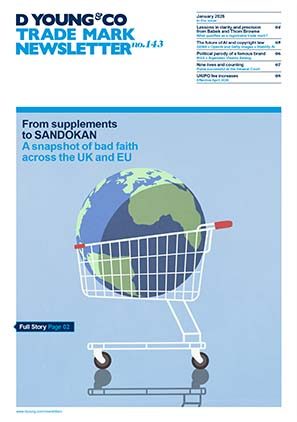Unregistered rights for protecting visual aspects of a product in the UK
When it comes to protecting the visual aspects of consumer products in the UK, registered rights, such as registered designs, trade marks, and patents, can be some of the most potent tools for dealing with third parties seeking to emulate these visual aspects in their own products.
Not to be overlooked, however, are a number of unregistered rights which, when used correctly, can be extremely helpful for dealing with such unwanted third party emulations. A brief overview of these unregistered rights follows below. This overview is not intended to be exhaustive, as noting the complete intricacies of each of these unregistered rights is beyond the scope of this deliberately brief overview. Nonetheless, the overview certainly gives a brief insight into the unregistered rights which exist in the UK, and when they may be of potential use in a given situation, albeit at a very high level.
UK unregistered design rights (UKUDR)
A UK unregistered design right typically manifests itself as soon as a design for a consumer product comes into being. The duration of UK unregistered design rights is the shorter of ten years from the end of the year in which first marketing of the product occurred, or fifteen years from the end of the year in which first creation of the design occurred. So around ten to fifteen years broadly speaking. However, in the last five years of this period of protection, if a third party asks for a licence to use this UK unregistered design rights a licence must be provided on reasonable terms.
There are some fairly stringent qualification requirements as to which entitles can qualify for UK unregistered design rights in their products. The recitation of their requirements in their entirety is beyond the scope of this article. Though broadly speaking on the assumption that the design for a product is created by a designer in the employment of UK entity, and/or is first marketed globally by a UK entity in the UK, then UK unregistered design rights protection for that product may come into being.
In terms of its application, a UK unregistered design right has the potential for protecting 3D visual aspects of a product. However, 2D aspects (such as surface decoration) of a product are not covered under UK unregistered design rights.
Supplementary UK unregistered design rights (SUKUDR)
Supplementary UK unregistered design rights have a shorter duration than UK unregistered design rights, in so far as supplementary UK unregistered design rights only lasts for three years from the date when the design for the product was first disclosed in the UK.
There are qualification requirements for a supplementary UK unregistered design right, in terms of only allowing this protection where the design of the product is first disclosed in the UK (or Gibraltar or the Channel Islands). First disclosing the design outside of these jurisdictions (for example, first disclosing the design in the European Union (EU), or the USA) will therefore rule out supplementary UK unregistered design rights protection.
Supplementary UK unregistered design rights can be used to protect 3D visual aspects of a product. However, unlike UK unregistered design rights, supplementary UK unregistered design rights can also be used to protect 2D visual aspects (such as surface decoration, or a logo) from a product.
Supplementary UK unregistered design rights protection was introduced in the UK following its departure from the EU. Supplementary UK unregistered design rights protection therefore largely mirrors a corresponding form of unregistered design right protection in the EU: so-called unregistered Community design (UCD) right protection, which is available for the design of a product which is instead first disclosed in the EU.
At the time of writing, it is not yet clear whether a design which is simultaneously disclosed in both the UK and the EU (for example, as part of a web disclosure targeting both UK and EU audiences) will attract both, or neither, supplementary UK unregistered design rights and UCD protection. So if supplementary UK unregistered design rights protection is of exclusive interest, a first disclosure of the design of a product in the UK alone may be a preferred option for best ensuring that supplementary UK unregistered design rights protection manifests itself in these instances.
Copyright
At least in the UK, it may be arguable in some circumstances that a consumer product (or a visual aspect of it) is an original “artistic work” (more specifically an original work of “artistic craftsmanship”) within the realms of copyright, so as to be able to argue for the manifestation of copyright in the appearance of this (visual aspect of the) product.
It is not straightforward to successfully argue that something is an ‘artistic work’ in these instances, particularly for consumer products, or visual aspects thereof, whose appearance is not original (for example, does not significantly depart from sector norms). In this respect, the UK has to date been somewhat stricter in (not) always affording copyright protection to the appearance of consumer products, compared with other jurisdictions in Europe. However, it is not beyond the realms of possibility, and so is always an option to at least consider.
To the extent that copyright can be shown to manifest in any visual aspect of a consumer product, as an artistic work, then the duration of this copyright protection is seventy years from the end of the calendar year in which the designer of the visual aspect dies (or from the death of the last of them to die, if there is more than one designer). There are specific rules where a work is of unknown authorship but in any event, the duration of any applicable copyright is much longer than the duration of any related UK unregistered design rights or supplementary UK unregistered design rights.
Enforcement of UK unregistered design rights (UKUDR), supplementary UK unregistered design rights (SUKUDR) and copyright
When enforcing any of UK unregistered design rights; supplementary UK unregistered design rights; or copyright in the UK against a third party, not only is it necessary to show a sufficient amount of visual similarity between the design right/copyright in question and the relevant visual aspect of the third party product, it is also necessary to show that the third party copied the appearance of the pertinent design right/copyright. So if the third party can demonstrate that they independently devised the appearance of their supposedly infringing product, sharing a visual similarity to the design right/copyright in question, the third party may use this fact to avoid any infringement of the design right/copyright.
This contrasts with the position with a registered design right, whose enforcement does not require this second step of demonstrating copying by the third party. So with a registered design right, the primary consideration is only whether the supposedly infringing product of the third party shares a sufficient visual similarity to the design registration in question.
Enforcing either UK unregistered design rights; supplementary UK unregistered design rights; or copyright in the UK also presupposes that the asserted design right/copyright was sufficiently new at the time when the design right/copyright was first devised. Put differently, if it turns out that the appearance of any asserted design right/copyright was in fact anticipated by some earlier disclosure, which is a disclosure that has a markedly similar appearance to that the design right/copyright in question, this may impact the validity of any such asserted design right/copyright.
Passing off
To the extent that goodwill is acquired through use of (an aspect of) the visual appearance of a consumer product, or its get-up, such that the relevant UK consumers would associate this visual aspect/get-up with a particular owner/brand, it may also be possible to rely on the unregistered right of passing off to deal with any competitor product that attempts to emulate this visual aspect/get-up in their own product.
Establishing passing off requires the demonstration of goodwill; misrepresentation; and damage.
In practice, this therefore means that if a party has acquired goodwill in the visual aspect or get-up of a particular product (through use in the UK), such that the later use of a third party product would cause a misrepresentation to consumers that the third party product is in some way connected with, endorsed by, or associated with the owner of the earlier unregistered right, and that this has potential to cause, or has caused, damage (for example, reputational harm or a financial loss) to that owner, a passing off action might be worth considering.
To be clear, relying on an action for passing off in the UK in respect of the get-up of a product alone is not without its particular challenges/limitations, but is at least something to always consider initially as a potential enforcement option, particularly where the get-up in question is ubiquitously well-known in the relevant UK market.
With respect to timings, an action for passing off relating to the visual appearance or get-up of a product may be brought so long as the party asserting passing off rights can claim goodwill in the visual aspect or get-up in question (assuming they have not been aware of the third party product for too long, without taking action). So for particularly successful products, the possibility of pursuing a passing off claim against third party products may persist long beyond the expiration of any related UK unregistered design rights or supplementary UK unregistered design rights.
In short
Unregistered design rights can be an incredibly helpful supplement, alongside any related registered rights, for protecting the visual aspects of a consumer product.
Deciding on which, if any, of these unregistered rights is worth pursuing in a given scenario will naturally depend on a number of factors, one of which notably being the age of the consumer product in question (which will have an impact as to which of the unregistered rights may still be in existence/enforceable).
In any case, it certainly pays to consider all the options; some may fit the bill much better than others! Our litigation specialists are well placed to advise on the pertinent options, and the potential useable rights, for a given scenario. So if in doubt, do not hesitate to get in touch.


